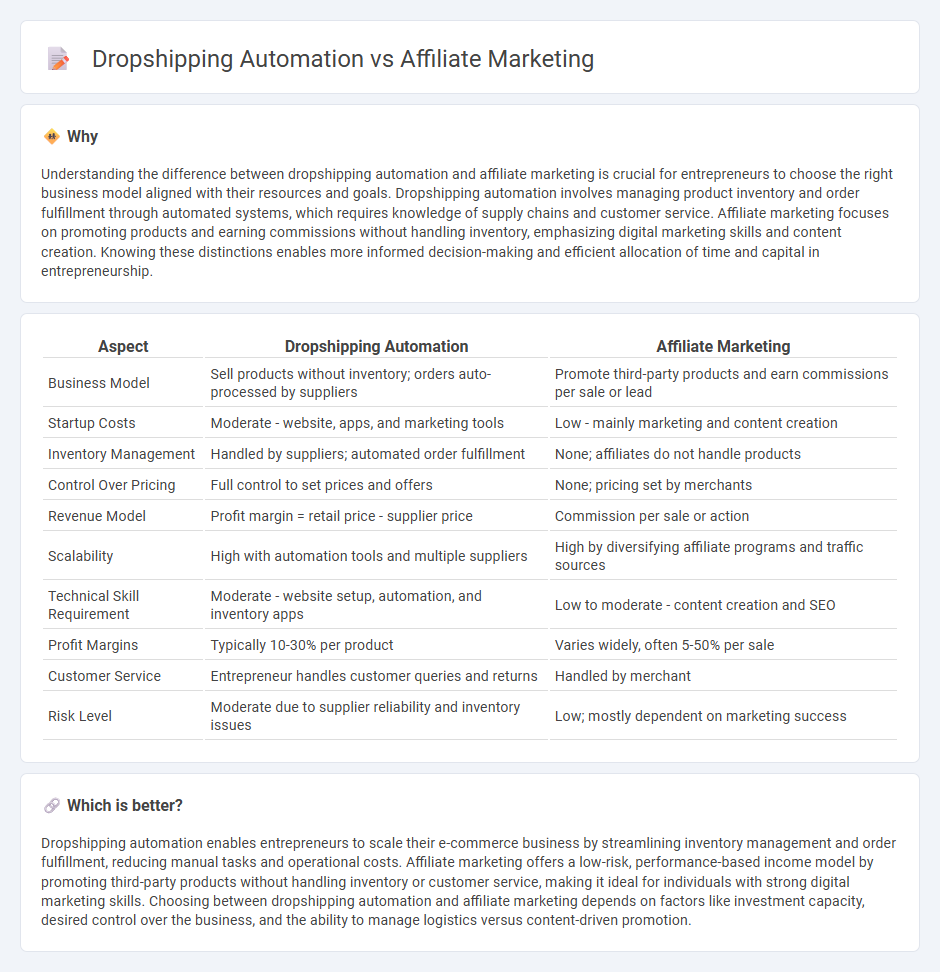
Dropshipping automation streamlines online retail by managing inventory, order fulfillment, and customer service without physical stock, while affiliate marketing focuses on earning commissions by promoting other companies' products through unique referral links. Both models offer low startup costs and scalability but differ in operational control and revenue mechanisms. Explore the advantages and challenges of each approach to determine the best fit for your entrepreneurial goals.
Why it is important
Understanding the difference between dropshipping automation and affiliate marketing is crucial for entrepreneurs to choose the right business model aligned with their resources and goals. Dropshipping automation involves managing product inventory and order fulfillment through automated systems, which requires knowledge of supply chains and customer service. Affiliate marketing focuses on promoting products and earning commissions without handling inventory, emphasizing digital marketing skills and content creation. Knowing these distinctions enables more informed decision-making and efficient allocation of time and capital in entrepreneurship.
Comparison Table
| Aspect | Dropshipping Automation | Affiliate Marketing |
|---|---|---|
| Business Model | Sell products without inventory; orders auto-processed by suppliers | Promote third-party products and earn commissions per sale or lead |
| Startup Costs | Moderate - website, apps, and marketing tools | Low - mainly marketing and content creation |
| Inventory Management | Handled by suppliers; automated order fulfillment | None; affiliates do not handle products |
| Control Over Pricing | Full control to set prices and offers | None; pricing set by merchants |
| Revenue Model | Profit margin = retail price - supplier price | Commission per sale or action |
| Scalability | High with automation tools and multiple suppliers | High by diversifying affiliate programs and traffic sources |
| Technical Skill Requirement | Moderate - website setup, automation, and inventory apps | Low to moderate - content creation and SEO |
| Profit Margins | Typically 10-30% per product | Varies widely, often 5-50% per sale |
| Customer Service | Entrepreneur handles customer queries and returns | Handled by merchant |
| Risk Level | Moderate due to supplier reliability and inventory issues | Low; mostly dependent on marketing success |
Which is better?
Dropshipping automation enables entrepreneurs to scale their e-commerce business by streamlining inventory management and order fulfillment, reducing manual tasks and operational costs. Affiliate marketing offers a low-risk, performance-based income model by promoting third-party products without handling inventory or customer service, making it ideal for individuals with strong digital marketing skills. Choosing between dropshipping automation and affiliate marketing depends on factors like investment capacity, desired control over the business, and the ability to manage logistics versus content-driven promotion.
Connection
Dropshipping automation streamlines order fulfillment and inventory management, enabling entrepreneurs to focus on scaling their affiliate marketing efforts by promoting products without holding stock. Affiliate marketing leverages targeted campaigns to drive traffic and sales, which complements dropshipping by increasing revenue without additional overhead. Combining these strategies optimizes operational efficiency and maximizes passive income streams for entrepreneurs.
Key Terms
Passive Income
Affiliate marketing automates passive income by promoting products through unique links, earning commissions without inventory management or customer service responsibilities. Dropshipping automation streamlines order processing and supplier communication, reducing manual tasks but requiring handling returns and customer relations. Explore detailed comparisons to determine which passive income model aligns best with your business goals.
Third-party Fulfillment
Affiliate marketing leverages third-party platforms to promote products without handling inventory, relying on referral links to earn commissions. Dropshipping automation integrates third-party fulfillment providers to manage inventory and shipping processes, enabling sellers to offer products without physical stock. Explore how optimizing third-party fulfillment can streamline operations and boost profits in both business models.
Traffic Generation
Affiliate marketing leverages content creation, SEO strategies, and social media to drive targeted traffic to affiliate offers, optimizing organic reach and conversion rates. Dropshipping automation centers on paid ads, product listing optimization, and retargeting to attract and convert consumers effectively on e-commerce platforms. Explore detailed strategies to maximize traffic generation in both models and boost your online business performance.
Source and External Links
Affiliate Marketing 101: What it is and How to Get Started - Affiliate marketing involves earning a commission by promoting another person's or company's products, with three key participants: sellers, affiliates, and consumers; affiliates market products to a specific audience to earn revenue share when purchases occur.
What Is Affiliate Marketing and How to Get Started - Affiliate marketing is a digital marketing model where third-party publishers promote a merchant's goods or services and earn commissions based on sales or traffic generated, suitable for bloggers, influencers, and content creators to monetize their platforms.
Affiliate Marketing Guide: All You Need To Know (2025) - Affiliate marketing is a performance-based strategy where affiliates receive commissions for driving desired actions such as sales, signups, or downloads through unique tracking links, with beginners advised to choose a niche, build content and audience, and follow program guidelines.
 dowidth.com
dowidth.com